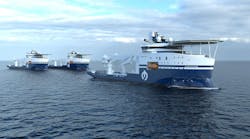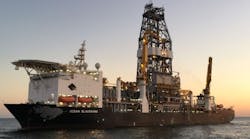Editor's note: This Vessels/Rigs column first appeared in the November-December 2023 issue of Offshore magazine. Click here to view the full issue.
By Bruce Beaubouef, Houston
A growing number of vessel owners and ship designers are looking to build or convert their ships to run on hydrogen fuel cells as a means of lowering the environmental footprint of offshore operations. Efforts have been concentrated in the growing offshore wind market, with projects focusing on designing new or converting existing crew transfer vessels, construction support vessels, service operation vessels and wind turbine installation vessels to run on hydrogen.
One recent example is Project Verdant, which aims to convert a crew transfer vessel (CTV) to run on hydrogen fuel cells while servicing offshore wind farms. Phase 1 of Project Verdant is now underway involving a preliminary design and feasibility study. If the concept is deemed viable subsequent project phases will seek to execute the concept design and test it in the field.
The project consortium is led by Orkney (Scotland)-based Green Marine, which supports the offshore renewable energy sector across Europe with marine engineering services, with project partners Waves Group and EMEC (European Marine Energy Centre).
Project Verdant’s conceptual design incorporates hydrogen fuel cells that are connected to electric motors, which can work in conjunction with the existing diesel-fueled engines, which can be shut down to enable zero emission operation at slow speed while working within offshore wind farms. This hybrid system could reduce the vessel’s CO2 emissions by up to 30% and NOx emissions by up to 40%.
Green Marine’s Managing Director Jason Schofield said the ultimate objective is to capture sufficient learning from the operation of a retro-fitted vessel to enable Green Marine to expand its fleet with new-build ZE CTVs (Zero Emissions Crew Transfer Vessels) and ultimately SOVs (service operation vessels), to support installation and maintenance activities in offshore wind farms in the UK and further afield.
Earlier this year, it was announced that an Edda Wind service vessel will take part in the Ship-aH2oy project, which will test out a new green hydrogen fuel technology. The goal of the Ship-aH2oy project is to develop a zero-emission propulsion technology on board ships using green hydrogen from a liquid organic hydrogen carrier (LOHC) on a megawatt scale.
The concept, based on the combined use of LOHC and solid oxide fuel cells (SOFC) as a powertrain, will be demonstrated on board one of Edda Wind’s commissioning/service operation vessels. Hydrogenious’ LOHC technology, with thermal oil benzyl toluene as the carrier material, will be deployed as part of the project. It is said to enable safe handling of hydrogen at ambient conditions.
Under the Ship-aH2oy project, Hydrogenious will supervise detailed design of the LOHC release unit and the integration with the service vessel, also interfacing with the SOFC supplier and supporting installation on the Edda Wind vessel.
Elsewhere, ship builder and designer Ulstein has also promoted the use of hydrogen as a fuel on some of its vessel designs in recent years. In 2019, Ulstein Design & Solutions BV introduced the ULSTEIN SX190 Zero Emission construction support vessel, Ulstein’s first hydrogen-powered offshore vessel design, featuring a Nedstack fuel cell power system. As designed, the DP-2 vessel would use proven and available technology to eliminate CO2, NOx, and particle emissions, and would support a variety of offshore support operations.
Ulstein said that the ULSTEIN SX190 would be able to operate four days in zero-emission mode. However, with the developments in hydrogen storage and fuel cell technologies, a future zero-emission endurance of up to two weeks is targeted, the company said. For extended missions and capabilities, the vessel could fall back on its more conventional diesel-electric system using low-sulphur marine diesel oil.
In 2020, Ulstein introduced its second hydrogen hybrid design for the offshore wind industry, the ULSTEIN J102 zero emission wind turbine installation vessel. The vessel design would be capable of operating 75% of the time in zero emission mode, the company said. The company said the hydrogen hybrid system of the ULSTEIN J102 design has been developed in such a way that future developments in hydrogen technology can easily be fitted into the vessel without major modifications.





